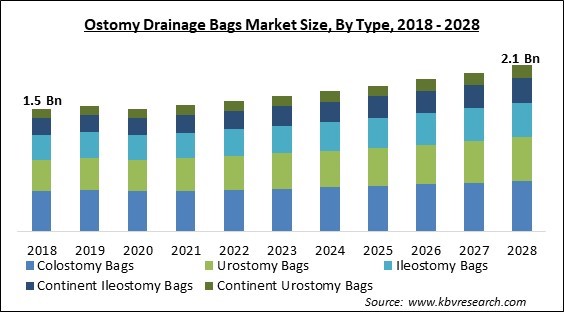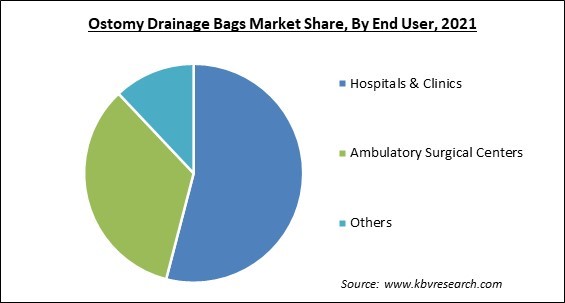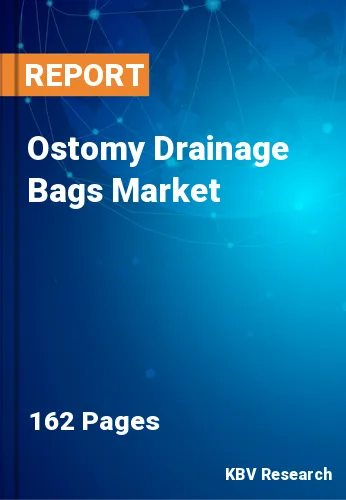The Global Ostomy Drainage Bags Market size is expected to reach $2.1 billion by 2028, rising at a market growth of 4.1% CAGR during the forecast period.
An ostomy drainage bag or pouching system is a prosthetic medical device that collects waste from a surgically redirected biological process (colon, ileum, bladder) and creates a stoma. Pouching systems are typically connected with ileostomies, colostomies, and urostomies. Pouching systems typically consist of a collection pouch, a skin barrier, and a connection to the stoma, which is the bodily portion that has been diverted to the skin. The solution may be a one-piece system comprising solely of a bag, or it may be a two-piece system consisting of a device put on the skin and a collection pouch attached mechanically or using an adhesive to form an airtight seal.

The system utilized differs across individuals and is frequently determined by medical necessity, personal desire, and way of life. Ostomy pouching systems catch feces produced by a stoma. The pouching method allows the stoma to flow into a sealed collection pouch while preventing contamination of the surrounding skin. They are utilized to retain independence so that the user can continue to engage in all types of sports and enjoyment.
An ostomy is a surgical procedure that creates a permanent or temporary skin opening known as a stoma. A stoma is a connection between an internal organ and the exterior of the abdomen. An ileostomy begins in the small intestine, whereas a colostomy begins in the large intestine. Both aid in the elimination of solid waste and gas from the body bypassing the rectum. A urostomy allows urine to exit the body bypassing the bladder. Waste is typically collected in a pouch placed outside the body for all ostomies.
The COVID-19 has significantly influenced the demand for ostomy drainage bags. Healthcare systems face logistical concerns, treating patients with the disease, prioritizing patients with comorbidity and pre-existing disorders, and protecting the public and frontline hospital staff from COVID-19 infection as their greatest challenges. The COVID-19 pandemic is projected to have a detrimental impact on the growth of the market for ostomy drainage bags. Because only the most urgent ostomy procedures have been performed due to COVID-19, the most negative impact in the globe, the market opportunity for ostomy drainage bags has been significantly impacted. In the post-COVID era, there is an increase in the utilization of ostomy bags due to the rising necessity to address certain trauma conditions.
Colorectal cancer and inflammatory bowel disease are the most prevalent illnesses that warrant ostomy surgery. Inflammatory bowel disorders (IBDs) are prevalent ailments in industrialized societies today. In Western nations, the prevalence of inflammatory bowel disease (IBD) continues to rise steadily, whereas, in newly industrialized nations, the incidence is rising rapidly. There appears to be a correlation between the expansion of IBD and the Westernization of diets and surroundings, which alters the intestinal flora and increases the likelihood of IBD in genetically susceptible.
The population aged 65 and over increased from 6% in 1990 to 9% in 2019. By 2050, this proportion is projected to rise to 16%, meaning that one out of every six people on the planet will be 65 or older. A 65-year-old person can expect to live an additional 17 years on average worldwide between 2015 and 2020. This amount would increase to 19 years between 2045 and 2050. Life expectancy at age 65 is projected to grow in all nations between 2015 and 2020 and 2045 and 2050. Currently, women outlive men by 4,8 years, but this gap is expected to narrow over the next three decades.
If patients have a colostomy but their anus is still intact, they may experience mucus discharge. The lining of the bowel produces mucus to facilitate defecation. The intestinal lining continues to produce mucus even if it serves no use. It can either seep out of the derriere or form a ball, both of which are painful. Some individuals get rectal discharge every few weeks, while others experience multiple bouts each day. Contact the doctor if the discharge contains blood or pus, as this may indicate an infection or tissue injury. Patients may find it helpful to sit on the toilet daily and pretend to defecate. This should eliminate any mucous and prevent it from forming a ball.

Based on the Type, the Ostomy Drainage Bags Market is segmented into Colostomy Bags, Ileostomy Bags, Urostomy Bags, Continent Ileostomy Bags, and Continent Urostomy Bags. The urostomy bags segment witnessed a significant revenue share in the ostomy drainage bags market in 2021. It is because it's a surgical technique that redirects urine away from a faulty or diseased bladder. The most common urostomies include ileal or cecal conduit operations
On the basis of End User, the Ostomy Drainage Bags Market is divided into Hospitals & Clinics, Ambulatory Surgical Centers and Others. The hospitals & clinics segment procured the highest revenue share in the ostomy drainage bags market in 2021. It is due to the increase in demand for ostomy drainage bags in hospital settings as a result of the availability of technologically enhanced goods that can service a broader population and increase patient comfort.
| Report Attribute | Details |
|---|---|
| Market size value in 2021 | USD 1.6 Billion |
| Market size forecast in 2028 | USD 2.1 Billion |
| Base Year | 2021 |
| Historical Period | 2018 to 2020 |
| Forecast Period | 2022 to 2028 |
| Revenue Growth Rate | CAGR of 4.1% from 2022 to 2028 |
| Number of Pages | 162 |
| Number of Tables | 280 |
| Report coverage | Market Trends, Revenue Estimation and Forecast, Segmentation Analysis, Regional and Country Breakdown, Companies Strategic Developments, Company Profiling |
| Segments covered | Type, End User, Region |
| Country scope | US, Canada, Mexico, Germany, UK, France, Russia, Spain, Italy, China, Japan, India, South Korea, Singapore, Malaysia, Brazil, Argentina, UAE, Saudi Arabia, South Africa, Nigeria |
| Growth Drivers |
|
| Restraints |
|
Region-wise, the Ostomy Drainage Bags Market is analyzed across North America, Europe, Asia Pacific, and LAMEA. The North America region procured the highest revenue share in the ostomy drainage bags market in 2021. This is due to an increase in the manufacture of ostomy drainage bags, the number of licenses for ostomy goods, the existence of important players, and the advancement of healthcare technology.
Free Valuable Insights: Global Ostomy Drainage Bags Market size to reach USD 2.1 Billion by 2028
The market research report covers the analysis of key stake holders of the market. Key companies profiled in the report include B. Braun Melsungen AG, Coloplast Group, ConvaTec Group PLC, Flexicare Medical Ltd., Hollister, Inc., ALCARE Co., Ltd., Oakmed Limited, Pelican Healthcare Limited, Salts Healthcare Ltd. and Welland Medical Limited
By Type
By End User
By Geography
The global Ostomy Drainage Bags Market size is expected to reach $2.1 billion by 2028.
Increased Prevalence of Inflammatory Bowel Disorders are driving the market in coming years, however, Urine Discharge from The Abdomen restraints the growth of the market.
B. Braun Melsungen AG, Coloplast Group, ConvaTec Group PLC, Flexicare Medical Ltd., Hollister, Inc., ALCARE Co., Ltd., Oakmed Limited, Pelican Healthcare Limited, Salts Healthcare Ltd. and Welland Medical Limited.
The expected CAGR of the Ostomy Drainage Bags Market is 4.1% from 2022 to 2028.
The Colostomy Bags market is leading the market in the Global Ostomy Drainage Bags Market by Type in 2021; thereby, achieving a market value of $633.4 million by 2028.
The North America market dominated the Global Ostomy Drainage Bags Market by Region in 2021; thereby, achieving a market value of $785.8 million by 2028.
Our team of dedicated experts can provide you with attractive expansion opportunities for your business.

